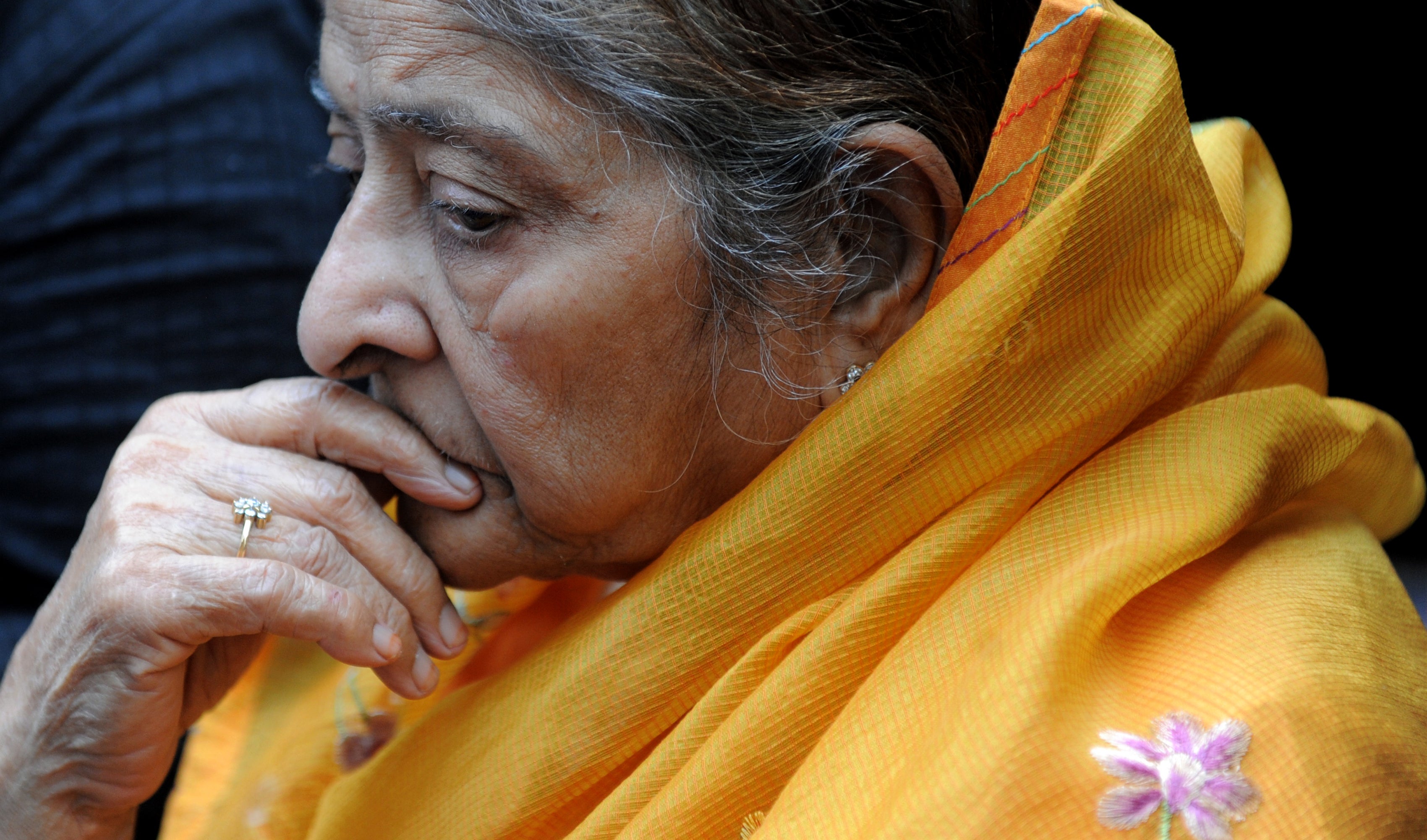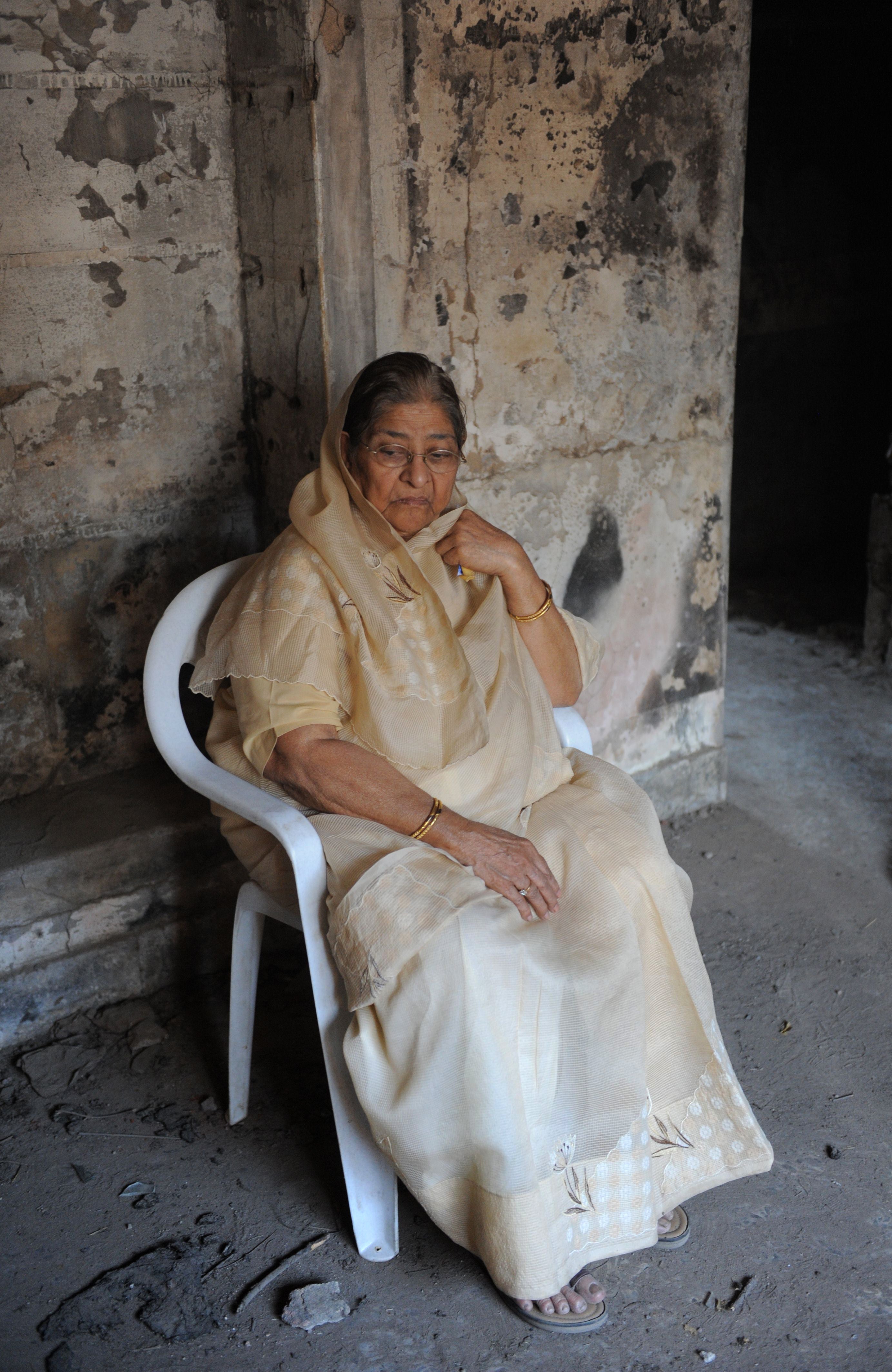Why an Indian widow is still fighting for justice for her husband who was killed by a mob in 2002
Zakia Jafri is challenging the closure of an investigation which cleared Narendra Modi of wrongdoing over the 2002 Gujarat riots, Sravasti Dasgupta reports

Zakia Jafri’s life turned upside down on 28 February, 2002.
A Hindu mob dragged her 72-year-old husband and Congress Party politician, Ehsan Jafri, out of their plush bungalow in Gujarat’s Gulberg Society, then tortured and killed him in front of her eyes.
Jafri, 64 at the time, could do nothing to save her husband. The state was under lockdown following the massacre of 59 Hindu pilgrims on the Sabarmati Express the day before. The lockdown was called by the radical right-wing Hindu group the Vishwa Hindu Parishad (VHP).
The 59 killed on the Sabarmati Express were mostly volunteers of Hindu organisations who perished when their coach was set on fire at Gujarat’s Godhra station by a suspected Muslim mob, though who lit the fire is often disputed.
It unleashed violence on such a scale across the state that it led to deep political ramifications and irreversibly altered relations between India’s majority Hindu and minority Muslim communities.
By the end of the day, Jafri had witnessed a violent mob not only kill her husband, but ransack the neighbourhood and set fire to her home of 30 years, forcing her and scores of her neighbours to leave barefoot in search of safety in a state simmering with communal tension.
As many as 1,180 died that dayacross the state.
Almost two decades after the carnage, Jafri, now 83, is back in India’s top court, challenging the findings of a Special Investigation Team (SIT) report, which cleared then-Gujarat chief minister, Narendra Modi, now the country’s prime minister, as well as other senior government figures.
The petitioners claimed Gujarat’s political leaders at the time conspired to allow the riots to happen so that Hindus could vent their anger over the Sabarmati Express deaths. Modi and the officials have always denied any wrongdoing.
In her petition, Jafri argues that the SIT report, submitted in 2012, needs to be re-examined as it ignored crucial evidence.
The case “attempts to pin responsibility for the Gujarat 2002 carnage on the people who were in power at the time… people who failed to prevent the spread of violence, and may have done so deliberately,” says the Citizens for Justice and Peace (CJP), a non-governmental organisation that is the second petitioner in the matter.
Jafri has argued, through her lawyer Kapil Sibal, that the purpose of the petition is not aimed at any single individual but to address the issue of communal violence.
“Communal violence is like lava erupting from a volcano, be it by any community. It is institutionalised violence,” Sibal said in court, according to LiveLaw.
“I don’t want to accuse A or B. A message must be sent to the world that this cannot be tolerated”.
“There has to be an investigation. That is all our case is about. If there is no investigation, what was the purpose of the Supreme Court constituting the SIT,” says Sibal.
Jafri says that simply getting the Supreme Court to hear arguments on the need to re-examine the SIT report is itself a form of victory. “I have full faith in the Indian judiciary,” she tells The Independent.
This February will mark the 20th anniversary of her husband’s death, and she has been in and out of courts for the past two decades.
On 8 June 2006, Jafri’s lawyers prepared an FIR (a form of initial police charge sheet) against 63 people including Modi and several ministers, bureaucrats in his government, senior police officers and leaders of right-wing groups.
“In 2003-04, news about the affidavits by the senior government officials to the Nanavati Commission started coming out in newspapers where they indicated a wider conspiracy by the government,” her eldest son Tanveer Jafri says.
The Nanavati Commission was appointed by the Gujarat government to probe the Sabarmati Express carnage and subsequent violence.
“When we were first filing my mother’s petition a lot of people asked her ‘are you sure you want to name these people?’. But she was always clear about what she had seen herself and the affidavits by these officials. She would say, these are top officers who have done their duty and recorded the truth. We must use this information in our fight,” Tanveer says.
However, the FIR did not get any response and she was then asked to approach the Gujarat High Court, but they also refused. So, they turned to the Supreme Court.
The Supreme Court passed an order in 2009 and asked the SIT that had been formed to probe the riots to also look into the evidence submitted in Jafri’s petition.
The petition includes her own eyewitness account of her husband’s death, as well as affidavits by senior police officials to the Nanavati Commission.
In subsequent years, both the commission and the SIT dismissed the evidence provided in Jafri’s petition, concluding there was no wider conspiracy by the Gujarat government.
“We challenged the closure report in High Court as well as the Magistrate’s Court but both refused saying that they don’t have the power to re-examine the report. That is why we returned to the Supreme Court in 2018 with the current petition, because what else do we do with so much evidence. Do we throw it away?” asks Tanveer.
When asked if she felt intimidated in taking on the state government and naming the top officials in the land, she says: “I am not scared of anything. I saw everything with my own eyes and I know the truth. I was watching when they tortured and killed him. This gives me the courage to fight.”
She says she did not have an inkling about the scale of violence that she witnessed that day.
“The shutdown had been declared so we were at home. Neighbours were over, discussing the shutdown with my husband. We had no idea what was happening outside,” she says.
But soon that changed. A violent mob of thousands gathered at the Gulberg Society and people were desperately running for cover.
“Our house was packed. About 200 people had gathered hoping that they would be saved if they stayed at Ehsan Jafri’s house,” she adds. “People kept pouring into our house and my husband never stopped anyone. He wanted to help as many people as he could.”
Chaos descended, and the mob arrived at their door. Jafri and around 50 others, mostly women and children, were sent upstairs by her husband to hide.
“I saw it all from the first floor where I was hiding. I saw them drag my husband out of the house, and brutally torture him. They stripped him, cut his fingers, arms, legs, slit his throat and paraded him to the crossroads of the housing society and then burnt him alive. I will never forget that day,” she says.
It was only in the evening that Jafri and the others who were hiding managed to leave the house.
“The ground floor had been burnt down. All the people who were there were killed. We survived only because we were upstairs,” she recalls.

With her three children out of town, she was on her own that night as she attempted to navigate what had just become of her life.
“Someone who my husband knew sent a tempo [small goods carrier] to Gulberg to get us. All of us who were on the first floor got on and we were dropped off on an open road near the police station. We were told it was too dangerous to take us any further,” she says.
“We all stayed there, without any food or water since noon until three or four boys who knew my husband came there and took us to an open field. There we stayed the night with others who had lost their homes and families in the carnage that day,” she adds.
It was only the next day that a family friend found her and took her to his house. “She called me the next day from their house and informed me that she is alive. Before that, I didn’t even know where she was.”
Tanveer, who lives in Surat, came to Ahmedabad the next day and brought her back to his house.
“I owe everything to my son. He has taken care of me and been with me every step of the way in my fight for justice,” she said.
Jafri has found support in several non-governmental groups like CJP, who have backed her throughout her long legal fight.
Many of those who supported her have faced their own legal battles – a form of intimidation, they allege. CJP secretary Teesta Setalvad faces several cases for embezzlement and violation of foreign exchange rules through her organisation.
Several police officers who testified to the Nanavati Commission and whose affidavits were used in her petition, have also been hit with a number of legal cases.
However, Jafri remains undeterred.
“They cannot take anything away from me,” she says. “I have already lost everything.”






Join our commenting forum
Join thought-provoking conversations, follow other Independent readers and see their replies
Comments